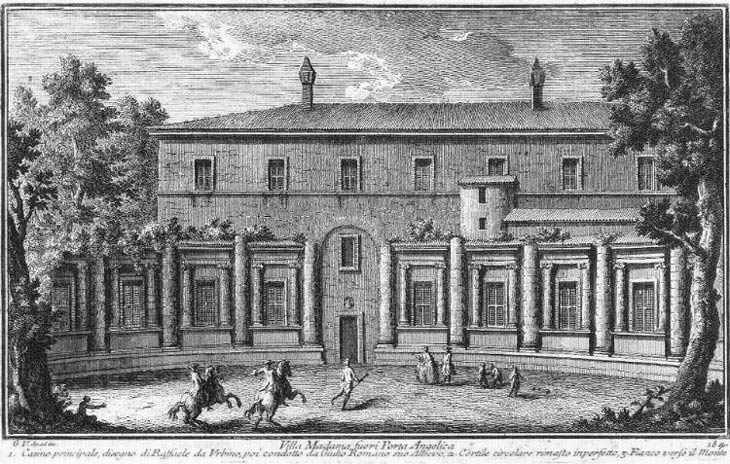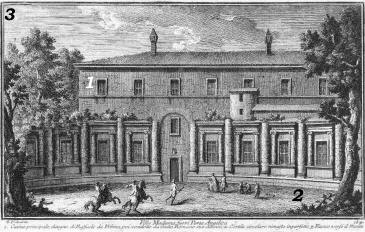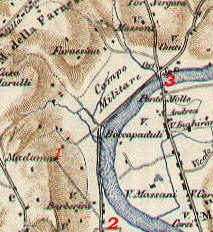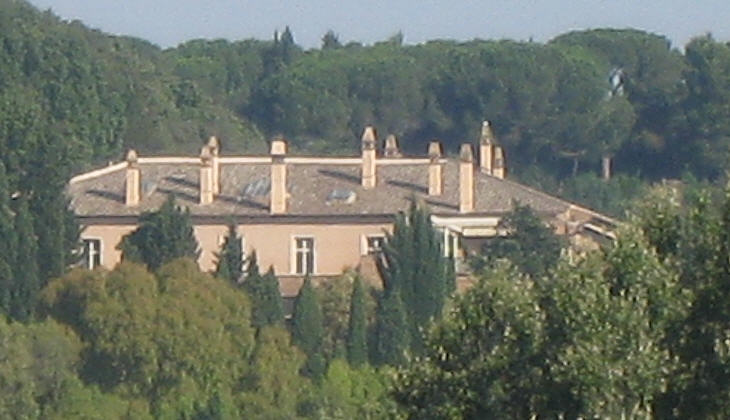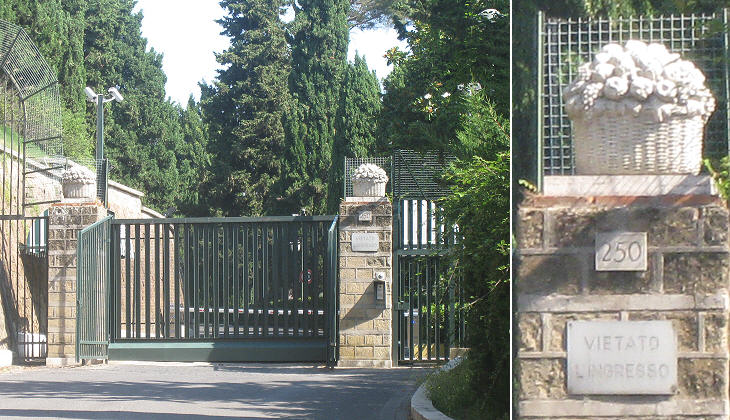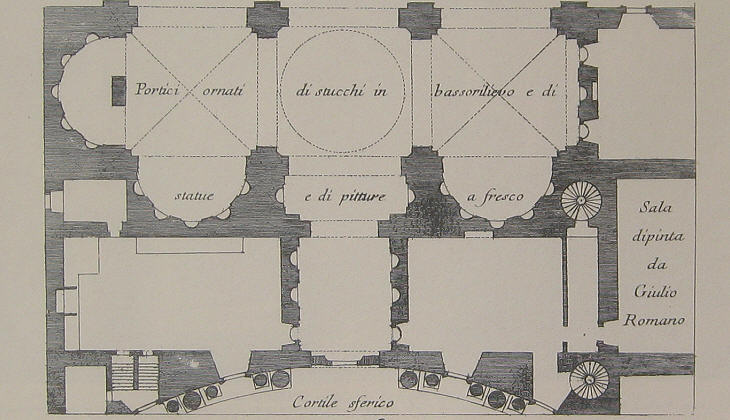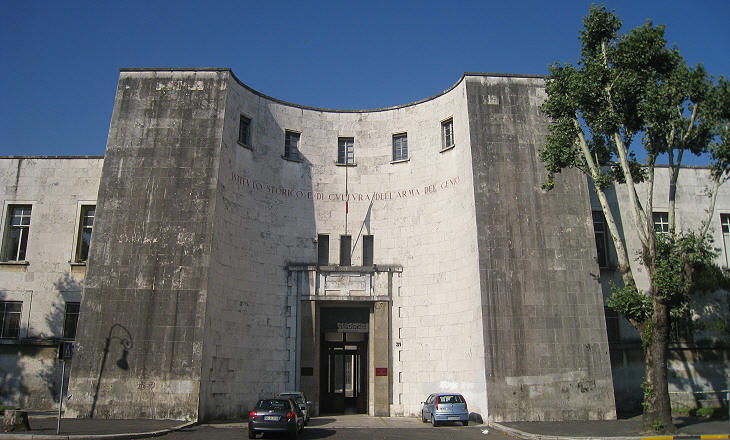

What's New!
Detailed Sitemap
All images © by Roberto Piperno, owner of the domain. Write to romapip@quipo.it. Text edited by Rosamie Moore.
Page revised in August 2010.
|

Villa Madama fuori
Porta Angelica (Book
10) (View C3) (Day
8)
In this page:
The plate by Giuseppe Vasi
Today's view
Villa Madama
Museo dell'Arma del Genio
The Plate (No. 184)
Villa Madama is located between Porta Angelica and Ponte Milvio;
when in 1760 Giuseppe Vasi visited it he found the site in such poor condition that he decided to leave a record of
the building for future generations; he therefore included two views and a plan of Villa Madama in his last book of etchings. At the time the villa belonged to the King of Naples, who inherited it from his mother, the last of the Farnese; similar to Palazzo Farnese and Orti Farnesiani the villa was stripped of its works of art which were sent to Caserta and Naples to embellish the royal palaces. The etching shows a spontaneous vegetation creeping along the small roofs of the circular courtyard and the casino gives the impression of being closed.
In the description below the plate Vasi made reference to: 1) Main casino designed by Raphael and completed by Giulio Romano; 2) circular courtyard which was not completed; 3) side towards the hill (Monte Mario). The small late XIXth century map here below shows: 1) Villa Madama;
2) site of today's Museo dell'Arma del Genio; 3) Ponte Molle (Milvio).
3) is shown in another page.
Today
The view in July 2010
Villa Madama was acquired by the Italian Government in the 1930s; it is now used by the Italian Foreign Office for dinners, conferences
and for hosting prominent visitors; for security reasons the premises are not open to the public and only the upper part of the casino is visible from a great distance. To the right of the building there is evidence of a modern terrace.
Villa
Madama
Modern entrance to Villa Madama
According to Vasi, Villa Madama was the first of its kind in Rome; while it is true that Casino del Belvedere was built a few years earlier, the design of the former anticipated those of many later villas, while the latter had the outer appearance of a small castle.
Villa Madama was built by Cardinal Giuliano dei Medici on the site of a farm bought by his cousin Pope Leo X; the casino was designed by Raphael, while Antonio da Sangallo the Younger gave advice on the structures needed for terracing the hill; after the death of Raphael, his scholar Giulio Romano completed and decorated the casino. In 1523 Cardinal Giuliano dei Medici was elected Pope Clement VII and at his death in 1534 the villa was inherited by Alessandro de' Medici and eventually by Margaret his widow; she was the natural daughter of Emperor Charles V and later she married Ottavio Farnese, grandson of Pope Paul III. Madama is a reference to Margaret which applies also to Palazzo
Madama, although this second property returned to the Medici at her death.
Plan of the casino by Giuseppe Vasi, showing that the building was very small
Read Henry James's account of his visit to Villa Madama in 1873, where the writer describes the appalling conditions of the site. Museo dell'Arma del
Genio
Fašade
The area surrounding Villa Madama was developed in the 1930s and it retains several examples of the monumental style which characterized that period; the project for this building was developed by Gennaro de Matteis, an officer of Arma del Genio (Military Engineering), who refrained from the excess of decoration which is visible in works of other architects of that period (see a page on EUR for more examples of this style).
Excerpts from Giuseppe Vasi 1761 Itinerary related to this page:
Villa Madama
Il Card. Giulio de' Medici eresse il nobilissimo casino di questa gran villa col disegno di
Raffaello da Urbino; ma passato questo all'altra vita, e assunto quello al Pontificato,
rimase imperfetto dalla parte di levante, ove si vede il principio di un magnifico
cortile in forma di teatro ornato di colonne. Nelle logge, che sono dall'altra parte
vi sono delli stucchi lavorati egregiamente da Gio. da Udine con bassirilievi e prospettive
a similitudine degli antichi, che sono stati veduti nelle rovine del Colosseo, ed altrove;
e nella sala sonovi delle pitture a fresco di Giulio Romano. Questa delizia gode tutti li
prati Quinzj, e il corso del Tevere fin dal ponte molle, e da una loggia nell'alto della
macchia si scopre mirabilmente tutta Roma. Spetta ora al mio Sovrano il Re delle due Sicilie.
Quindi scendendo al basso, e proseguendo il cammino per lo stradone alberato verso Ponte molle,
si vedono a sinistra delle vigne.
|
Next plate in Book 10: Secondo Prospetto del Casino di
Villa Madama
Next step in Day 8 itinerary: Secondo Prospetto
del Casino di Villa Madama
|



